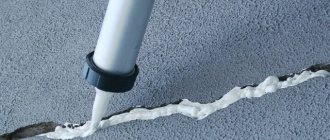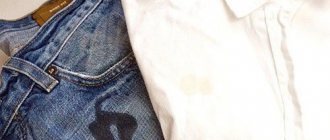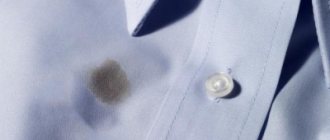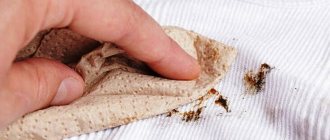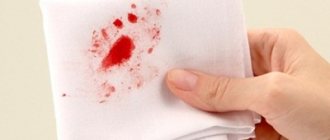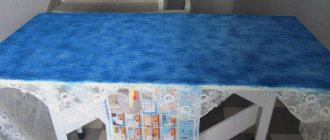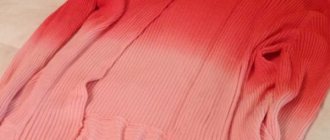Date: 10/24/2017
What to do if you don’t want to part with your favorite things, but they have already lost their original appearance and become faded? There is only one way out; they can be repainted. The question is especially often asked on forums: how to dye jeans in a washing machine? This procedure scares some housewives, but it is worth saying that there is nothing complicated about it. The main thing is to choose the right paint for dyeing clothes and follow all the recommendations indicated on the packaging with the coloring composition.
Choosing paint for dyeing clothes
We live in an age of abundance. The chemical industry offers such a rich assortment that it can be difficult to decide what paint to paint clothes with. It is simply not possible to define all types of dyes in one article. Therefore, we will limit ourselves to a list and a brief description of the main types of things used to paint things.
- Aniline - recommended only for dyeing products made from natural fibers.
- Oil ones are the most difficult to use, but with guaranteed and long-term results.
- Acrylic - can be used not only for cotton, but also for silk fabrics.
- Water-glycerin - used to obtain radical dark shades (for example, black or dark blue).
What fabrics can be dyed?
In principle, you can dye any fabric with your own hands. But, of course, subject to certain conditions. However, you should know that not every fabric modulates color equally well. Thus, the intensity of staining may vary. It is important to note:
- You should always refrain from dyeing synthetic fibers such as polyester.
- Fabrics containing 60 percent or more natural fibers can be dyed easily and without problems. These include cotton, viscose, linen, satin, chintz, etc.
- The seams of clothing are most often made of synthetic threads. They absorb color with difficulty or not at all and therefore, in most cases, retain their original color. There may be a clear contrast. Before you paint things, pay attention to this.
Hand dyeing clothes
In this case, use only textile dye intended specifically for hand dyeing.
- Mix the paint in a large container with water and salt. When painting by hand, do not forget about gloves. Otherwise, paint your hands at the same time.
- Now place the clothes in the water solution and give it a certain time to work. Depending on time, the color intensity becomes stronger or weaker.
- Then all that remains is to wash the clothes in the machine with a mild detergent.
Preparing for coloring
Before you dye your down jacket at home, you need to clean it very thoroughly. To complete this process as quickly as possible and without sad consequences, you can contact a dry cleaner. Another cleaning option is the washing machine. This stage is important, otherwise the paint may lie unevenly.
Cleaning a jacket in a washing machine is as follows:
- the wardrobe element must be placed inside the machine;
- add a cleaning agent, preferably a liquid one;
- set the washing mode to “Delicate”;
- Disable "spin".
If you want to wash your down jacket by hand, you can do it at home. To do this, you need to purchase cleaning products, when using which you should follow the instructions:
- the product must be laid out on a flat surface;
- a solution is made from the purchased product (detailed description in the instructions), into which you need to dip a sponge;
- wash contaminated areas.
This procedure should be performed with gloves to protect the delicate skin of the hands from the harmful effects of abrasive substances. If there are stubborn greasy stains on the down jacket, then you need to get rid of them, otherwise after painting these places will stand out strongly. To remove contaminants, you need to prepare a mixture of 1 tbsp. l. ammonia and the same amount of dishwashing detergent. The ingredients must be mixed until a homogeneous foam is formed, then applied with a brush or washcloth to problem areas and rub well. When the jacket is cleaned, the treated areas should be washed with a sponge and hung to dry.
How to dye things in the washing machine
This type of coloring is simple and clean in the truest sense of the word.
- First of all, select textile paints of the desired tone.
- First, the fabric must be weighed to calculate the required amount of dye. Information can usually be found on the back of the package or on an instruction leaflet.
- Place the laundry in the washing machine and wash at 40° without detergent. Before doing this, open the paint bag and pour its contents into the detergent compartment.
- Set the rinse mode, and then the spin cycle. Wait until the program finishes and then wash the freshly dyed clothes again, but with a small amount of detergent.
How to care for painted items
All items require special care after dyeing. The following rules must be followed:
- Do not dry clothes in direct sunlight. This makes her burn out.
- You need to wash dyed items several times separately from the rest of your laundry.
- Each time after washing, during the last rinse, add a little vinegar to the water.
- To wash colored items, you must use a special powder, without various bleaches.
With the help of coloring, old things can be brought back to life, but only if you do everything correctly. It is worth considering that if there are various stains on the clothing, they will not be painted over evenly, and the color will still differ from the general shade.
Dyeing clothes using natural means
If you prefer to use natural products when dyeing clothes, then the following ingredients are what you need!
- Turmeric: The spice makes your clothes shine bright yellow.
- Spinach: Adds a touch of soft greens.
- Blackberry: Depending on the base tone, it turns out red or pink.
- Sea buckthorn: bright orange.
- Wormwood plus alum: lemon.
- Beetroot: from rich burgundy to soft pink.
- Henna: from red to red.
- Coffee, tea: from beige and cream to brown.
In order to prepare a dye from natural ingredients, first grind the raw materials and simmer them over low heat for half an hour. Approximate ratio: 200 grams per liter of water. Then you will need to strain through several layers of gauze - the natural paint is ready!
Dyeing clothes using mordant
Of course, you first need to thoroughly wash contaminated clothes so that no stains remain on them.
- Next, boil the item to be painted for one to two hours with water and mordant (a chemical preparation that fixes the paint in the fiber structure). The optimal amount is one teaspoon of mordant per liter of water. Boil over low heat to allow the color to penetrate deeper into the fibers.
- Then let the fabric simmer until it reaches the desired color. Stir again and again - this is necessary for a uniform result.
- Finally, to remove excess color, rinse your freshly dyed clothes in the washing machine.
Dyeing process
Before you begin directly dyeing, you must first remove all buttons and other elements for decoration from the clothing.
If this is not done, traces of rust may remain on the jacket. Dyeing clothes consists of stages:
- dilute the dye;
- dip the down jacket into the resulting solution;
- after the desired shade has been obtained, remove the product and allow it to dry, which should only happen at room temperature or outside, but in the shade from the sun's rays.
When working with paint, you must wear gloves to protect your hands from chemical exposure and so that no trace of the dye remains on them.
Advice! Before dyeing all the clothes, experts recommend testing the dye on fabric of the same texture and looking at the result.
Dyeing a down jacket at home in a washing machine
Once the preparation process is completed, you can proceed to the coloring itself. To protect your skin from paint, you must wear gloves. You can dye a down jacket only when all unnecessary elements have been removed from it, and the dye has passed the test for results. Before you start dyeing your clothes yourself, you need to pay attention to the material they are made of. For synthetic fabrics, chemical-based paints are suitable. If the color change occurs in the washing machine, then the dye must be poured into it in a proportion of 1 kg per 1 packet of textile paint.
The required amount of dye must be dissolved in water at room temperature and poured into the powder compartment. This must be done when the machine has finished drawing water. Features of painting a down jacket black in the washing machine:
- an additional “Rinse” mode is required;
- to consolidate the result, you need to rinse the down jacket with vinegar;
- The jacket will fade, especially the first 2-3 washes.
Important! Dyeing a down jacket in a washing machine is possible provided that the unit has a vertical loading - the dye solution is poured directly into it.
Dyeing a down jacket at a dry cleaner
You can also dry-clean your outerwear. To find an organization that provides such a service, you will have to run around. This can be explained by the fact that even a professional and proven dye can behave unpredictably.
Dry cleaning is the best and safest option thanks to:
- Dry cleaners minimize the risk of unexpected results. For this purpose, they take a piece of down jacket fabric and test the reaction of the dye used on it.
- If outerwear needs to be cleaned, it will be done in accordance with the instructions on the label.
- All fittings and fur elements are removed before painting;
- Painting is carried out on modern equipment using high-quality dyes.
- The down filling does not fall off thanks to drying in a special dryer.
In the future, cleaning and dyeing of a down jacket should also be done in a dry cleaner.
Dyeing clothes black
The technology for dyeing fabric black is practically no different from other shades.
- So, let's prepare the coloring composition. Mix warm water with your chosen dye. The dosage is determined in accordance with the manufacturer's instructions.
- Immerse the thoroughly washed and dried item in the solution so that it completely covers the fabric.
- Over the course of half an hour, turn the product over several times, trying to lay it out as evenly as possible, without creases or folds.
- Once the fabric has acquired an intense black color, proceed to rinsing. To do this, pour vinegar into clean cold water at the rate of 2 tablespoons per 5 liters of water. Rinse thoroughly and hang to dry.
- If a product made of wool or silk fabric is dyed, it is better to add 25% vinegar essence to the rinsing water rather than vinegar.
Attention! You should not paint several products at once - only one at a time. Otherwise, there is a high probability of some areas not being painted.
Which paint should you prefer?
Before you start dyeing things, you need to choose a suitable dye. All fabric paints are labeled with the type of fabric they are intended for. If the composition of the clothing is not entirely clear, it is better to purchase a dye that says it is universal. The most common fabric dyes are the following brands:
- “Surf” is a universal fabric paint that is suitable for both natural and artificial fabrics. This brand produces five different shades. It is worth considering that one small bag of paint is designed for half a kilo of dry laundry;
- Simplicol - this dye is intended for dyeing natural and mixed fabrics. The paint packaging states that it cannot be used for dyeing natural wool, silk and cashmere. This dye contains a special fixative; this dye is optimal for dyeing things in the washing machine.
- Fashion Color is a durable paint for dyeing high quality fabrics from a German manufacturer. There are many different colors in the palette; this dye is ideal for dyeing things in the washing machine. Just one small packet of paint is enough for 1.5 kg of dry laundry.
When choosing a paint, you can ask the household chemicals seller to recommend a suitable coloring composition for a particular fabric.
It is worth considering that the color stated on the packaging by the manufacturer is obtained only when dyeing white fabrics. If the color of the fabric is different, then the shade will be different.
How to paint things blue
The easiest way to paint is with blue – this is a classic and quite effective method. But it should be noted that for this purpose, even if you are dyeing blue clothes, only water-soluble compounds are suitable.
- Wash and rinse thoroughly the item to be repainted.
- Prepare a concentrated blue solution. Proceed in full accordance with the instructions.
- Pour the resulting solution into water and stir until smooth.
- Immerse the product in the container and straighten it completely.
- To get a soft blue color, 10 minutes is enough. For a deeper tone it will take 1.5 hours. Denim fabric, depending on its density, will require at least two hours to be completely dyed. (Read more about how to dye jeans at home in our article).
Important Tips
Before you begin the procedure of dyeing things, you need to study the list of recommendations.
- First you need to carefully weigh the pros and cons. You need to understand that when dyeing clothes amateurishly, expectations and reality can be radically different.
- You need to know exactly the composition of the fabric. It is not uncommon for the composition stated on the label to be completely untrue.
- You need to decide exactly what color you want. You can dye it in colors that are slightly darker than the original color of the item. The final result can be assessed objectively only after the clothes have completely dried, since the color of wet clothes is slightly darker. If the shade of the diluted paint does not inspire confidence. It’s better not to take risks, as you can permanently damage the item. In industrial conditions, paints are tested many times before dyeing fabric. With amateur coloring, there is only one attempt.
- It is advisable to test the paint on a small piece of fabric of similar composition. In this case, you can understand what result to expect.
- When painting things, you need to wear old clothes. Have a wet cloth ready in case the paint spills.
- If the dye is in powder form, then it is first diluted in water and then filtered through a couple of layers of gauze.
- It is necessary to work with rubber gloves so as not to get your hands dirty.
To get a good result, you must strictly follow the instructions on the paint package.
It is worth considering that things fade a lot after painting. The water stains the most during the first wash, then the shedding decreases with each wash.
When working with paint, you should not inhale its vapors, as this can lead to severe allergies. The room in which things are dyed must be well ventilated.


